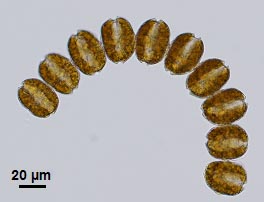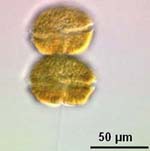Research in Marine Ecosystems
The coastal marine toxigenic dinoflagellate Alexandrium monilatum

The chain-forming dinoflagellate, Alexandrium monilatum.
The CAAE has two strains of this organism, courtesy of NOAA-NOS Charleston (toxic strain from colleague Dr. Steve Morton; toxicity confirmed by Dr. Peter Moeller) and Dr. Paul Hargraves (URI; nontoxic strain). Toxic strains of this large dinoflagellate (mean diameter ~50 μm) produce endotoxins with hemolytic and neurotoxic properties, and have been linked to fish and invertebrate kills in the Gulf of Mexico and, recently, Chesapeake Bay.

Alexandrium monilatum
(photo, S. Pate May)
- Reducing clearance rate and valve gape, affecting food intake
- Causing mortality of adults, juveniles, and larvae, potentially affecting recruitment
The coastal marine toxigenic dinoflagellate Karenia brevis
In collaboration with Dr. Pat Glibert (UMD) and Visiting Fulbright Scholar Dr. Allassane Ouattara (Université d’Abobo-Adjamé, Côte d’Ivoire ), the CAAE completed a two-year study to assess how nutrient pollution affects the main Florida red tide species, K. brevis. This issue has been of great interest to the people of Florida, many of whom have called for researchers outside the state to objectively examine the response of K. brevis to nutrient over-enrichment.
In Part I of this study (with Dr. Glibert; see Glibert et al. 2009, Aquat. Microb. Ecol.55: 17-30), six experiments that were completed to assess the growth response of K. brevis to a range of dissolved nitrogen pollutants, simulating realistic pollution levels and other environmental conditions. In Part II (with Dr. Ouattara; manuscript in preparation), four experiments were used to examine how phosphatidic clay additions from phosphate mining activities in Florida affect removal of toxic K. brevis from the water column and its subsequent survival in waters enriched with N or P.
Major findings from Part I were that
- At a light level that commonly supports K. brevis blooms, this species can grow well on the three most common forms of dissolved N – NH4 +, NO3 -, and urea; and
- K. brevis is a voracious predator (grazer) on the cyano-bacterium Synechococcus which, in Florida coastal water, has been shown to be strongly stimulated by P pollution. Grazing by K. brevis on Synechococcus expands the range of nutrient substrates available to meet its growth requirements, and grazing likely plays a substantial role in sustaining natural blooms along Florida’s coastal waters.

Hypotheses supported by the Part I experiments: Both direct stimulation of K. brevis by nutrient enrichment, and indirect stimulation mediated through stimulation of microbes (e.g. Syn = Synechococcus) that K. brevis consumes as prey.
Major findings from these experiments were that
- high phosphatidic clay concentrations (500 mg/L) can control bloom densities of K. brevis over short periods (but such levels are detrimental to benthic shellfish);
- residual K. brevis populations remaining in the water column after exposure to 250 mg clay/L, or sedimented populations exposed to 100 mg clay/L, are capable of forming new blooms;
- nutrient-poor populations of K. brevis can be stimulated by the PO4 -3 derived from exposure to moderate levels (100 mg/L) of phosphatidic clay; and
- K. brevis can be stimulated by inorganic nitrogen enrichment, but not by PO4 -3 enrichment, after exposure to moderate additions of phosphatidic clay.
